
Varvara Brackmann, Volker Hoffmann
The material is based on the dissertation of Varvara Brackmann (born Efimova)
The application of a pulsed power supply of glow discharge (GD) in optical emission spectrometry (OES) has a number of advantages in comparison with the continuous one. The reason is that in case of Pulsed Glow Discharge(PGD) the power is applied only during short periods of time with a certain frequency. This allows the reduction of sputtering rate and of sample heating. Therefore the PGD is preferable for the analysis of thin layers and heat-sensitive samples.
However, the use of PGD in commercial spectrometers has still some limitations:
In the present work the influence of the duty cycle, pulse duration and frequency on the PGD is investigated and compared for direct current (dc) and radio frequency (rf) discharges. In the research the attention is firstly paid on the electrical parameters of PGD, then on the crater shapes, sputtering rates and finally on the light emission. With the help of the studies carried out, the measurement of depth profiles of thermally fragile samples with pulsed rf GD OES is optimized. A quantification procedure was successfully applied to the measured depth profiles. In the following text the main parts of the present work as well as some results are described.
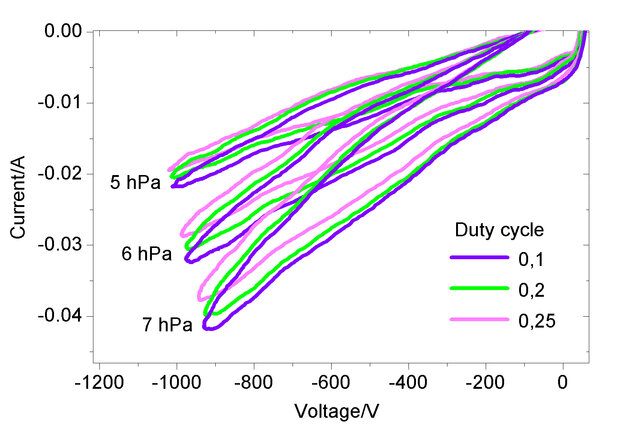
The studies of the rf and dc PGD were performed on labmade sources. Firstly it was ensured that the measured current and voltage correspond to the real values and any measurement artefacts are eliminated. It was observed that the electrical circuit of the pulsed system can strongly affect the produced voltage and current signals. The observation of the voltage current characteristics behaviour varying different pulsed parameters helped us to understand some of the PGD principles. The measured electrical characteristics of PGD indicated the heating of the discharge gas with introduced power, mainly at higher duty cycles [1]. Moreover the discharge gas temperature was estimated from the voltage-current characteristics [2].
The discharge gas temperature depends on the temperature of the source boundaries, mainly of the sample and anode. Therefore the influence of different anode materials in a Grimm-type source on the voltage-current characteristics, crater shapes and GD spectra was investigated in collaboration with Research Institute for Solid State Physics and Optics in Budapest [3].

The study of sputtering rates and especially crater shapes of PGD is quite important for the GD OES depth profiling. We observed that (1) the sputtering rate is proportional to the duty cycle and (2) the crater shape is mostly affected by the pulse duration (see Fig. 2). The change of the duty cycle at constant pulse duration doesn’t lead to a significant deformation of the crater. From these studies we learned that to get a flat crater, which is extremely important for the measurement of the depth profiles, one can vary the pulse duration [4].
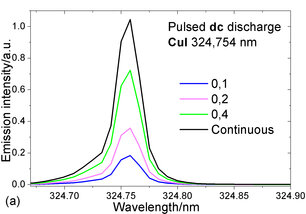
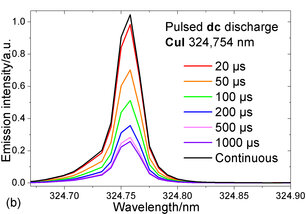
As a next step the light emission of PGD was examined. Firstly two detector types were considered: PMT and CCD. At first we had to decide, which detector is most suitable for the detection of the PGD emission: PMT or CCD. One should take into account that a PMT measures the intensity with a certain frequency, namely every 500 µs at our PMT spectrometer, while at our CCD instrument the emission is permanently measured and the signal is averaged at minimum every 10 ms (one can set the integration time from 10 ms to some s). Sometimes the emission measured by PMT can show oscillations because the measurement moments hit not the same pulse time or even sometimes the gap between the pulses. So when working with PMT detection one should find an optimal pulse frequency which provides constant signal. To avoid any uncertainties and limitations of the frequency, for our further studies we used CCD detection. Additionally, the CCD detection system provides continuous spectra in a wide spectral range which allowed us to observe the behaviour of all emission lines simultaneously. It was found out that the emission intensity is proportional to the duty cycle, when pulse duration is kept constant. Changes of the pulse duration at constant duty cycle strongly affects the CCD spectrum (see Fig. 3).
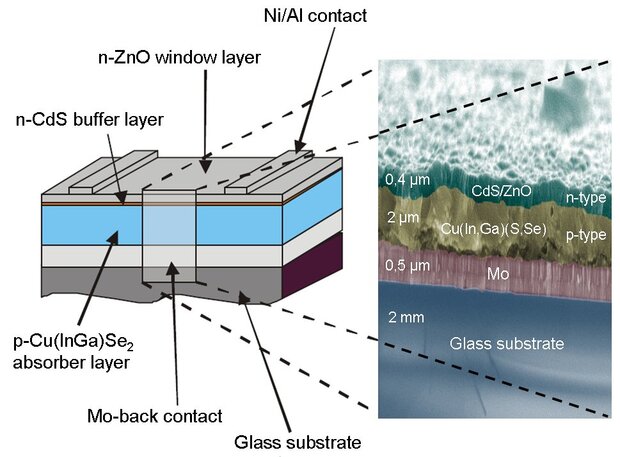
In the next stage we applied the obtained knowledge about the PGD for improved GD OES analysis of industrial samples. Therefore based on the previous studies, firstly the methodic of PGD parameters optimization for the GD OES depth profiling was developed. All GD OES measurements were performed with spectrometers from the company Spectruma Analytik GmbH.
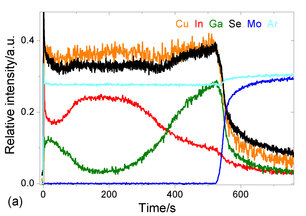
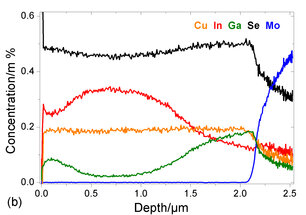
The solar cell samples (Fig. 4) are heat sensitive and can be analyzed only using PGD. The PGD parameters were optimized according to the developed optimization method. A quantification procedure was applied to the measured depth profiles and the calculated concentrations and depths showed a good agreement with XRF and AES measurements. This means that the quantification model, which is created for continuous discharge, is valid also for the pulsed discharge. The measured and quantified depth profiles of the CIGSe thin film on Mo coated soda-lime glass (SLG) are presented in Fig 5. (see also [5,6,7,8]).